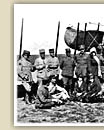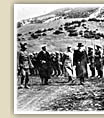|
|
 |
 |
 |
 |
 |
 |
 |
 |
 |
 |
|
From September 1916, following the decision of the revolutionary government of Thessaloniki, Greece participated in the First World War on the side of the Entente.
|

To this end new military units had to be formed, since the organized army
had sided with the government of Athens. Apart from the limited number of officers
there was also a serious shortage of military equipment. Nevertheless, the first formation
of the new army, the 1st Battalion of National Defence, was ready by mid-September
and was forwarded to the Macedonian front to reinforce the Allies that had already been
deployed in the area. Other units followed, to finally make up eleven divisions.
In 1917 the Allies were in a difficult position. The capture of Romania by the troops
of the Central Powers allowed the latter to be easily supplied in grain and oil and gave them
the chance to reinforce the Macedonian front. By contrast, the Allied army confronted problems
in supply and transport of reserves. The front extended from the River
Strymon to northern Epirus. On the side of the Entente, 243 battalions, French, British,
Serbian, Italian, Russian and Greek were deployed, whereas facing them were approximately an equivalent
number of Central Power troops, German, Bulgarian, Ottoman and Austrian. Throughout the year
engagements took place with no spectacular results.
In June 1917 Venizelos became once more the Prime Minister of the now unified Greek state,
after the departure of Constantine. The government of Athens had by now officially declared war on
the Central Powers. From that point onwards attempts at reorganizing the army and achieving
the greatest Greek participation possible in the allied operations became more intense.
|
 |

The task was not an easy one, given the negative disposition of many inhabitants
of Old Greece regarding the country's involvement in the war on the side of the Allies. This
attitude was acute because of the pressure of the blockade imposed by the Entente on southern
Greece, but was also dictated by its removal of Constantine as a political solution
to the problem of the National Schism. For this reason, in Old Greece mobilization took place slowly,
and new recruits came only gradually, mostly from the newer classes, and were coloured by the political
climate of each area. In the 'New Territories', by contrast, where Venizelists prevailed, and especially
in the islands of the Archipelago, Crete and Macedonia, mobilization was effected quickly
and the troops were rapidly forwarded to the front. The full deployment of the Greek army took place only as late as
the first part of 1918.
The Greek army eventually participated with determination in the development of the war
in the Balkan peninsula. In May 1918 Greek military units held a leading part
in the Battle of Skra di Legen, the most important among the local offensives, that resulted in the
capture of a strongly fortified position, controlled until then by the Central Powers, chiefly
Bulgarian troops. The Battle of Skra confirmed the fighting readiness
of the Greek army in the eyes of the allies, an army that had only just been restructured. After that the preconditions
for the allied counter-attack had been laid, an attack that was launched in September of that
same year. This was marked by a series of victories and the continuous advances of the allied
troops that led Bulgaria to capitulation on 17/30 September 1918. The capitulation of Turkey
followed with the Mudros Armistice that signalled the termination of war in the Balkans,
just before it finally ended with the capitulation of Germany and Austria-Hungary.
|
 |
 |
|
